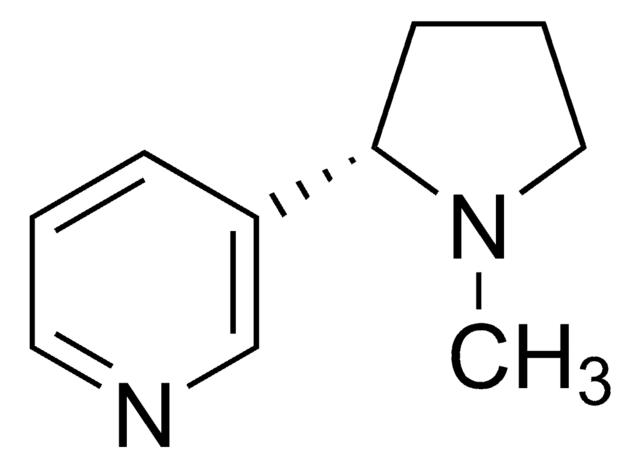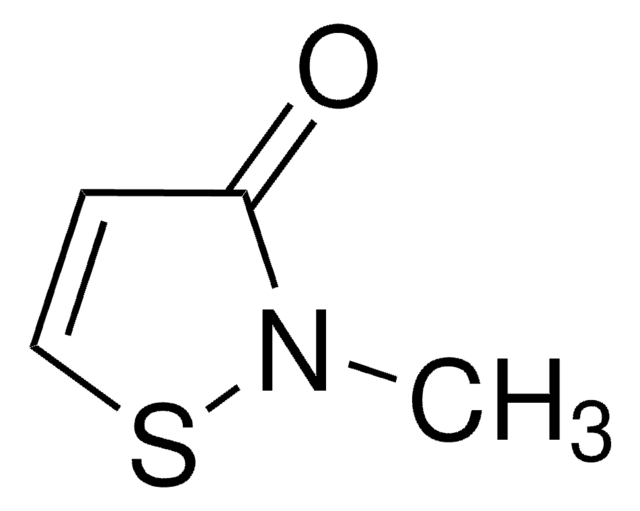34392
Methyldibromoglutaronitrile
analytical standard
동의어(들):
1,2-Dibromo-2,4-dicyanobutane, 1-Bromo-1-(bromomethyl)-1,3-propanedicarbonitrile, 2-Bromo-2-(bromomethyl)glutaronitrile
로그인조직 및 계약 가격 보기
모든 사진(2)
About This Item
실험식(Hill 표기법):
C6H6Br2N2
CAS Number:
Molecular Weight:
265.93
EC Number:
MDL number:
UNSPSC 코드:
85151701
PubChem Substance ID:
NACRES:
NA.24
추천 제품
Grade
analytical standard
Quality Level
유통기한
limited shelf life, expiry date on the label
기술
HPLC: suitable
gas chromatography (GC): suitable
mp
51-55 °C
응용 분야
environmental
형식
neat
저장 온도
2-8°C
SMILES string
BrCC(Br)(CCC#N)C#N
InChI
1S/C6H6Br2N2/c7-4-6(8,5-10)2-1-3-9/h1-2,4H2
InChI key
DHVLDKHFGIVEIP-UHFFFAOYSA-N
일반 설명
Methyldibromoglutaronitrile (MDBGN) is a bromine-containing preservative and a clinically significant allergen as investigated from animal/human clinical studies.
Methyldibromoglutaronitrile can be generally used as a preservative in the cosmetic industry for many skin care products.
애플리케이션
Methyldibromoglutaronitrile may be used as an analytical reference standard for the quantification of the analyte in cosmetic products using ultra performance liquid chromatography (UPLC) coupled to inductively coupled plasma mass spectrometry (ICP-MS) and gas chromatography followed by mass spectrometry technique.
Refer to the product′s Certificate of Analysis for more information on a suitable instrument technique. Contact Technical Service for further support.
추천 제품
Find a digital Reference Material for this product available on our online platform ChemisTwin® for NMR. You can use this digital equivalent on ChemisTwin® for your sample identity confirmation and compound quantification (with digital external standard). An NMR spectrum of this substance can be viewed and an online comparison against your sample can be performed with a few mouseclicks. Learn more here and start your free trial.
신호어
Danger
유해 및 위험 성명서
Hazard Classifications
Acute Tox. 4 Oral - Skin Corr. 1B
Storage Class Code
8A - Combustible corrosive hazardous materials
WGK
WGK 2
Flash Point (°F)
Not applicable
Flash Point (°C)
Not applicable
개인 보호 장비
Eyeshields, Faceshields, Gloves, type P3 (EN 143) respirator cartridges
Axel Schnuch et al.
Contact dermatitis, 56(6), 331-337 (2007-06-20)
Although genetic factors probably account for differences in susceptibility to contact allergy, they have not yet been identified, partly due to an insufficient understanding of 'susceptibility'. Regarding polysensitization (PS) as a sign of increased susceptibility, we studied the relationship between
Louise Arup Fischer et al.
Contact dermatitis, 61(4), 201-208 (2009-10-15)
Allergic contact dermatitis is common and can be prevented. The relationship between thresholds for patch tests and the repeated open application test (ROAT) is unclear. It would be desirable if patch test and ROAT data from already sensitized individuals could
Patch testing with methyldibromoglutaronitrile
Geier J, et al.
American Journal of Contact Dermatitis : Official Journal of the American Contact Dermatitis Society, 11, 207-212 (2000)
S Ada et al.
Journal of the European Academy of Dermatology and Venereology : JEADV, 24(10), 1192-1196 (2010-03-20)
Cosmetics are the causative agents in 8-15% of patients suspected of having allergic contact dermatitis. Patch testing with standard series identifies 70-80% of the responsible allergens in all contact dermatitis; however, many important cosmetic-related allergens may be missed by using
Huijun Liu et al.
Bulletin of environmental contamination and toxicology, 92(4), 451-454 (2014-02-20)
The dissipation and residues of bromothalonil in apple and soil under field condition were analyzed by QuEChERS (quick, easy, cheap, effective, rugged and safe) combined with gas chromatography-mass spectrometer method. The recoveries were ranged from 80.8 % to 106 %
자사의 과학자팀은 생명 과학, 재료 과학, 화학 합성, 크로마토그래피, 분석 및 기타 많은 영역을 포함한 모든 과학 분야에 경험이 있습니다..
고객지원팀으로 연락바랍니다.


![Benzo[a]pyrene-d12 98 atom % D](/deepweb/assets/sigmaaldrich/product/structures/962/892/b867e1bb-083c-4337-b499-36eae87f40ad/640/b867e1bb-083c-4337-b499-36eae87f40ad.png)





![Benzo[a]pyrene ≥96% (HPLC)](/deepweb/assets/sigmaaldrich/product/structures/253/820/be96d879-1811-46c0-8f11-612019691c2d/640/be96d879-1811-46c0-8f11-612019691c2d.png)

